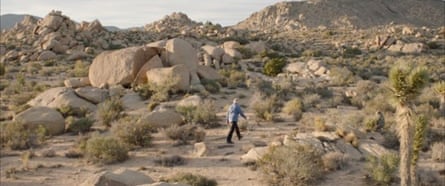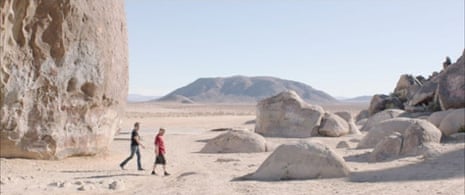Although believed to be the largest free-standing boulder in the world, Giant Rock, which stands seven storeys tall in the mountainous southern Mojave desert, attracts few tourists, doesn’t appear in any guidebook and is an absolute nightmare to get to, requiring a hairy drive over three kilometres of winding dirt roads and hump-backed dunes that feels like a fairground ride from hell. If you didn’t have a reason to come, you probably wouldn’t bother. And if you don’t know how to get there, you’d likely never find it.
Considered sacred by Native Americans, presumed by locals to be an asteroid dropped from outer space, Giant Rock has never had any trouble attracting colourful characters – from the 1930s prospector who lived in rooms carved out beneath it, to the thousands of UFO believers who trekked here for annual conventions in the 1950s. All of which have lent this strange monolith a pop culture notoriety that continues to draw those in the know to this day.
On a bright, clear day as the sun boils down, two figures pace around this impressive lump of granite in southern California, a camera crew following their every step. Overseeing the shoot is the French artist Pierre Bismuth, the man who came up with the original story for Eternal Sunshine of the Spotless Mind, Michel Gondry’s dizzying tale of love, loss and memory. The 2004 film won the Frenchman a shared Oscar for best original screenplay, and he’s now out at Giant Rock to shoot his debut feature film, a documentary of sorts entitled Where Is Rocky II? “I like to describe it as a fake fiction,” he says.

The jumping-off point for Bismuth’s film is his long-standing fascination with a little-known and unexhibited work by the American artist Ed Ruscha: an artificial rock made out of resin and named Rocky II after the Sylvester Stallone movie. A BBC crew filmed Ruscha during its creation for a 1980 documentary, which also captured him depositing the work somewhere in the Mojave desert, where it has apparently remained ever since, indistinguishable from all the other rocks around it.
This “undetectability” tickled Bismuth. “What is an art piece that nobody can see?” he says. “That’s already quite an interesting statement. But more than that, what is an art piece that nobody knows about? I mean, this is really pushing it. I understand that an artist can do an invisible piece, but a piece that no one knows is kind of weird. It’s beyond any kind of conceptual statement you can have.”
Bismuth first saw the BBC documentary 10 years ago, around the time he won the Oscar and was considering his options. “With that thing in my hand, I realised it would be totally silly not to try to do something else in film, to capitalise on that success, because it was so unbelievable.” He began his own investigation into Rocky II, talking to people who knew or had worked with Ruscha, many of whom had never even heard of the rock. Rocky II is so mysterious it neither appears on the call for information about missing artworks listed on the artist’s website, nor in the catalogue listing all his known works – almost as if its existence has been intentionally obscured. “I really started to think I was crazy,” Bismuth says. “I was glad I had a tape of the film, because otherwise I would have thought I’d dreamt it.”
The closer he got to Ruscha, the more he was “met with a weird silence”. Eventually, he realised he would have to confront the artist himself. So, posing as a journalist with a camera crew in tow, he attended the press conference for the Ruscha retrospective at London’s Hayward Gallery in 2009. There he “aggressively” posed the question: “Where is Rocky number two?” Footage of Ruscha’s reaction, clearly caught off guard but amused, opens Bismuth’s film. While acknowledging the artwork’s existence, he declined to reveal its location, wishing Bismuth “good luck” in his search.
“If I could have found anything quickly or easily,” he says, “I would have dropped the idea of doing the movie.” Instead, he pressed on, hiring a hardbitten, retired homicide detective turned private investigator called Michael Scott to search for the rock. Then he recruited two Hollywood screenwriters: DV DeVincentis (whose credits include High Fidelity, Grosse Point Blank and forthcoming Johnny Depp vehicle The Night Stalker) and Anthony Peckham (writer of Clint Eastwood’s Invictus and Guy Ritchie’s Sherlock Holmes). They were given details about the detective’s investigation and told to turn his quest into a fictional story. Meanwhile, Bismuth would film all three of them at work: the PI following leads, the screenwriters out in the parched scrub and sand, looking for inspiration and great locations such as Giant Rock.

Bismuth believes the detective and the writers were engaged in essentially the same process. “The private investigator, in order to find the truth, will develop some crazy theories that turn out to be, in the end, totally fictional. And the screenwriter, in order to create fiction, has to start from real fact. I thought it was interesting the way they go in opposite directions and probably cross in the middle.”
DeVincentis, rangy, nervy, cool, and Peckham, rounder, more measured and intellectual, make for a mismatched pair but have an engaging rapport, both onscreen and off. Watching Bismuth direct the writers in the desert, his style is less improvisational that to invite him into his own head.
Bismuth is a voluble figure, bursting with ideas that seem to be ever-evolving, becoming grander and at the same time more personal as he expounds upon them. He somehow seems to be both sure of what’s he’s doing and making it up as he goes along. The film and its conceptual nature, much like Bismuth’s visual art, reflects his desire to better understand the world by creating unexpected shifts in the everyday meaning of things, in order to question how we perceive. He’ll take something apparently trivial or overlooked from pop culture and imbue it with such significance that it almost collapses under the weight of its new mythology. For Collages for Men, a series from 2001, he took images of naked women from pornographic magazines and “clothed them” with bits of white paper cut into, say, the shape of a bathing suit or a dress. The basic idea, he explains, is to “try to destroy something with its own logic” and thereby create a fresh new work.
Consequently, Ruscha’s mythical artwork also became a blank canvas on which to project other ideas. Whenever the search for Rocky II felt futile, the characters and scenarios Bismuth encountered along the way kept him going. Jim Ganzer, an artist, surfer and the person Ruscha turned to for help in constructing Rocky II, threw himself into Scott’s investigation. “He was smoking pot all day,” Bismuth says. “A very seductive, very charming person, but very laidback – as he says himself, ‘the laziest person in the world’.” Bismuth later discovered Ganzer had partly been the inspiration for the Dude, Jeff Bridges’s character in the Coen brothers’ The Big Lebowski. An unabashed movie buff who loves to reference other films when discussing his own work, he found having Ganzer onboard “extremely exciting”.
This article includes content hosted on indiegogo.com. We ask for your permission before anything is loaded, as the provider may be using cookies and other technologies. To view this content, click 'Allow and continue'.
Now that his decade-long quest is almost at an end with the film 90% complete, Bismuth and his producer have launched a crowdfunding campaign to get them over the last hurdle: shooting the fictional short film scripted by DeVincentis and Peckham. Bismuth describes this as “the cherry on the cake”, for a film attempting to “blur the distinction between reality and fiction”.
Naturally, this is no ordinary crowdfunding campaign. It takes the form of a treasure hunt, with donors invited to search for Rocky II by playing private detective, coming up with their own theories and shooting their own short films. The plan is to premiere the completed project early next year. “For me,” Bismuth writes on the crowdfunding site, “Where Is Rocky II? is about more than Ed Ruscha and finding his hidden art. It is a film about how we project fantasies – and how works of art can be the perfect objects of fantasy.”
Bismuth is understandably tightlipped about whether he actually found Ruscha’s rock out there in the vast expanse of the Mojave desert, which stretches across three states from California to Utah. One gets the sense that, even if he had, total satisfaction would still somehow elude him.

Comments (…)
Sign in or create your Guardian account to join the discussion